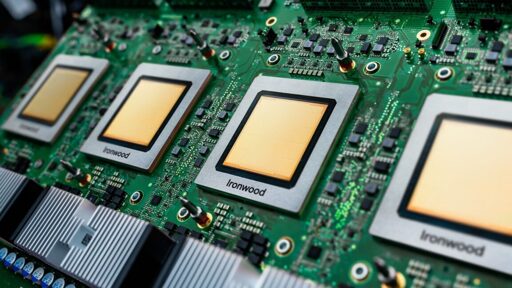It was probably always when, not if, Google would add its name to the list of companies intrigued by the potential of orbiting data centers.
Google announced Tuesday a new initiative, named Project Suncatcher, to examine the feasibility of bringing artificial intelligence to space. The idea is to deploy swarms of satellites in low-Earth orbit, each carrying Google’s AI accelerator chips designed for training, content generation, synthetic speech and vision, and predictive modeling. Google calls these chips Tensor Processing Units, or TPUs.
“Project Suncatcher is a moonshot exploring a new frontier: equipping solar-powered satellite constellations with TPUs and free-space optical links to one day scale machine learning compute in space,” Google wrote in a blog post.
“Like any moonshot, it’s going to require us to solve a lot of complex engineering challenges,” Google’s CEO, Sundar Pichai, wrote on X. Pichai noted that Google’s early tests show the company’s TPUs can withstand the intense radiation they will encounter in space. “However, significant challenges still remain like thermal management and on-orbit system reliability.”



I still don’t understand how they’re gunna dump that amount of heat in any efficient manner.
I am a bit late to this party, but I thought I’d piggy back on your comment to halfway address it using math.
We want to run data centers cool. This means keeping the center itself as close to 20°C as possible.
If we lose our convection and conduction then our satellite can only radiate away heat. The formula governing a black body radiator is P = σAT^4. We will neglect radiation received, though this is not actually a negligible amount.
If we set T = 20°C = 294K. Then we have the relationship of P/A = 423.6 W/m^2
According to an article I found on the Register from this April:
This would imply a surface area of at minimum 23600 m^2 or 5.8 acres of radiator.
I don’t know how large, physically, such a pod would be. But looking at the satellite view of a google data center in Ohio that I could find, the total footprint area of one of the large building of their data centers is ballpark in that range. I don’t know how many “pods” that building contains.
So it’s not completely outside of the realm of possibility. It’s probably something that can be engineered with some care, despite my earlier misgivings. But putting things in orbit is very expensive, and latency is also a big factor. I can’t think of any particular practical advantages to putting this stuff into orbit other than getting them out of the jurisdiction of governments. (Not counting the hype and stock song and dance from simply announcing you’re going to set a few billion dollars on fire to put AI into space.)
The issue not that it’s technically possible, the issue is that it’s an extra, complex, heavy, and maintenance requiring system.
Ultimately the issue is the tyranny of the rocket equation. That amount of cooling surface would be stupidly heavy, like that’s a huge payload on top of the huge payload of the solar panels and compute. Like, the ISS is 420 tons, and it has a max power output of 240 kw. The ISS has to be assembled in orbit and was a monumental undertaking and technical challenge.
They’re not going to do something an order of magnitude larger than that, the capacity to launch and assemble something like that does not exist. Building that capacity would require an Apollo style generational effort.
This is a very obvious and desperate attempt to keep attention and hype up. To throw out an uplifting and technically impressive proposal to distract from the reality that the tech industry has collectively set a trillion dollars on fire.
Oh man, I completely didn’t think about maintenance. Yeah, a data center will typically have several hard drives swapped per day. You’d have to have life support and a staff up there, as well as frequent resupply trips.
As much as I dislike AI… radiators are just about the most efficient technologies, besides space heaters, which do the same thing.
It’s like how incandescent lighting is 100% efficient, if you also include all of the frequencies we can’t see (primarily infrared.)
If I’m wrong, I’m hoping someone will correct me, but I’m fairly certain that radiators in the shadow of the rest of the satellite’s body would be able to dump that heat as infrared into space.
Radiators on Earth have conduction and convection available to them as well as radiation. Conduction and especially convection account for the vast majority of heat shed from the radiator.
Radiators in space have only radiation available.
Radiators typically need to have something to vent the heat into. While there is still a slight atmosphere in LEO, I fail to see how it would be more efficient than doing it all on the ground. Servers are basically heaters that do fancy things in the middle, they’ll have much more heat than a standard LEO satellite. Plus, in LEO, you constantly have to correct your orbit (or burn up). Then, you have to also be able to cool down while in the sun, and likely heat up in the dark. On top of that, good luck if you have hardware fail. Then there’s latency on top of it all.
My point is that how is all of that more efficient than doing it on the ground, where you don’t have to consider these things?
I don’t mean transfer to the air, I mean radiating heat!
When you have a hot object, in space or in an atmosphere, you can see it on infrared cameras because it’s releasing that energy as infrared light.
Some materials are better at releasing their heat energy as infrared light than others, and having large panels of such a material gives lots of surface area to radiate that energy into space as infrared radiation. The heat transfer to any thin atmosphere found at that kind of altitude would be negligible.
As for heating up in the dark, you could just have a swarm of these that shut down if they’re in the dark, and make sure you have at least a few running at all times.
As for maintenance, I agree. It’s why undersea data centers haven’t really taken off, because it’s very hard to get people down there to take care of things.
I know what you meant. You’re missing my point. Servers at this scale heat up much more than your average satellite. There is no efficiency gain, only loss, it’s really not efficient compared to even closed loop cooling systems on the ground, and they don’t even want to use closed loop as it stands.
What would the benefit of having swarms of these in space be? I don’t see the benefit in any sense. It’s more expensive, you cannot do maintenance, it costs much more money, and you cannot shoot entire datacenters into space with as much ease as just building them on the ground in the first place.
It seems to me that they just want another way to generate attention and money. They’ll shoot one of these up there, and then continue to waste water on the ground anyway.
Considering how much the largest companies are making deals with and just handing money to each other during this AI bubble… I’m not sure money is a concern.
The more that they can bedazzle the concept of a data center and distract from the failures of current LLMs, the more money they can make, which very much aligns with what you’re saying.
Thank you for providing that little bit of context, and apologies for misunderstanding. Have a great day! :)